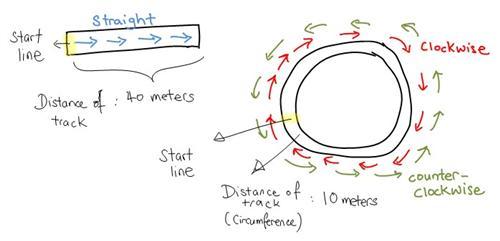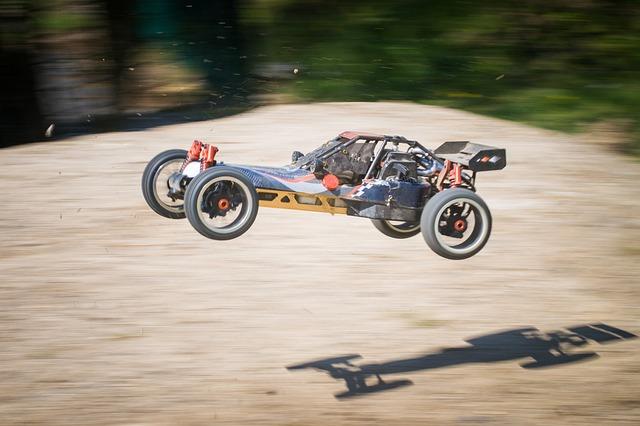| Complexity level: | 5 |
| Project cost ($): | 140 |
| Time required: | Preparation will take approximately one hour, while observation and recording of data will require one day |
| Material availability: | Easily found at toy store |
| Safety concerns: | Safety concerns:Observe proper road safety - never play on an actual road. Find a safe, secluded place (eg. basketball court) to perform your experiment |
Hypothesis
A firmer spring will increase the speed of a radio controlled car.
Overview
Radio controlled (RC) cars
Radio controlled cars are model vehicles that are operated using a remote controller. The operator of the remote controller is usually located at a distance away from the car, and commands are given through the use of a joystick on the remote controller. The remote controller uses a transmitter to send radio signals that will be picked up by the antenna and receiver in the car. These signals are then interpreted by the electronic circuitry in the car as commands to move, turn or stop.
Radio controlled (RC) cars are available as either toy or hobby cars. Toy cars are affordable and are normally sold in department stores and toy stores. They can be found in various attractive colors and shapes, and typically come fully assembled. However, spare parts are not readily available when these cars break down.
RC cars for hobbyists are normally sold as kits and require self assembly. These cars require regular maintenance to ensure proper performance and to prevent breakdowns. Spare parts are readily available, which enables modifications and upgrading of such vehicles. As these cars are made using stronger materials, they are more durable are suitable for high speed and obstacle course racing. These RC hobby cars are typically more expensive.
Scientific Terms
Materials
Materials required for this science fair project:
- 1 XMODS RC car
- 1 XMODS high resistance spring
- 1 XMODS medium resistance spring
- 1 XMODS low resistance spring
- 1 spare battery
- 80 empty soda cans or bottles
- 1 piece of chalk
- 1 measuring tape
- 1 string (10 meters long)
- 1 stop watch
- 1 unused car park area
Procedure
1. The independent variable in this science fair project is the resistance of the spring used in the RC car. The dependent variable is the time taken by the RC car to travel 10 meters, which is measured using a stopwatch. The constants (control variables) are the type of car, the surface conditions of the road or track, and the distance that the car travels.
2. The tests will be conducted using a straight line course of 10 meters and another course that is also 10 meters long but contains a lot corners and turns.
3. Prepare the straight line course by marking both the start and finishing lines, which are 10 meters apart, using the chalk. Arrange forty soda cans on each side of the course. The width of the course should be approximately 600 mm.
4. To prepare the course containing the corners and turns, place the 10 meter string on the floor to plan the route of the course. Arrange another forty soda cans on each side of the string to mark the course. The width of the course should also be fixed at 600 mm.
5. Install the RC car with the high resistance spring. Make five test runs on both courses. Measure the time taken to complete the 10 meter course using the stopwatch, and calculate the average time taken for the five test runs. Record the data in the table given below.
6. Repeat procedure 5 using the medium resistance spring and the low resistance spring. Calculate the average time taken and record all data in the table given below.

Results
Springs that had large and medium resistance were observed to increase the speed of the RC car for the straight line course when compared to the spring that has the lowest resistance. However, for the course with the corners and turns, the speed of the RC car was observed to be the fastest when it was set up with springs that had the lowest resistance.
| Course Type | Time taken by RC car using different spring resistance (seconds) | ||
| Large | Medium | Low | |
| Straight line course | 4.45 | 4.52 | 5.27 |
| Corner & turn course | 16.25 | 15.33 | 12.47 |
Conclusion
The experimental data and analyzed results support the hypothesis that the spring with a larger resistance will increase the speed of the radio controlled car. However, this is only true to a certain extent, as the effect was only observed for the straight line course. For the course that consisted of corners and turns, an increase in the speed of the RC car was only observed when the car was fixed with springs that had the lowest resistance.
Due to the increase in popularity of the hobby, there is growing demand for remote controlled cars and their accessories. The RC cars meant for hobbyist are usually sold as unassembled kits, as assembling the cars on its own enables hobbyists to learn engineering and operational fundamentals of the RC car. This also helps them to learn how to perform maintenance and upgrading work on their cars.
Also consider
Try to repeat this science fair project by using a different model of RC car such as the Kyosho brand cars.
The experiment can also be repeated by changing other accessories in the car such as the type of tires used.
References
Radio controlled car - http://en.wikipedia.org/wiki/Radio-controlled_car
Which car to buy? - http://www.rchobbies.org/cars_what-to-buy.htm
RC car information - http://www.juliantrubin.com/encyclopedia/engineering/rc_car.html

